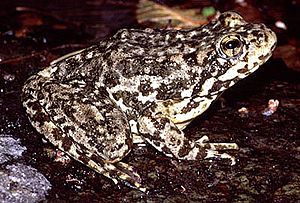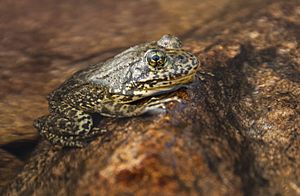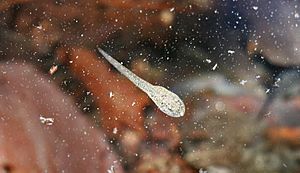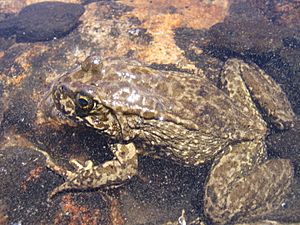Mountain yellow-legged frog facts for kids
Quick facts for kids Mountain yellow-legged frog |
|
|---|---|
 |
|
| Conservation status | |
| Scientific classification | |
| Synonyms | |
|
The mountain yellow-legged frog (Rana muscosa) is a special type of frog. It is also called the southern mountain yellow-legged frog. This frog lives only in California, United States. You can find it in the San Jacinto Mountains, San Bernardino Mountains, and San Gabriel Mountains in Southern California. It also lives in the southern Sierra Nevada. This frog is an endangered species, which means it is in danger of disappearing forever.
Some mountain yellow-legged frogs in the northern Sierra Nevada are now called a new species. They are known as the Rana sierrae. This new species is also considered endangered. The mountains near the Kings River separate where these two frog species live.
Contents
What Does It Look Like?
The mountain yellow-legged frog is about 4 to 8.9 centimeters long. That's about 1.5 to 3.5 inches. Its color can be different. It might be yellowish, brownish, or olive green. It also has black and brown spots. Its scientific name, muscosa, means "mossy" in Latin. This name comes from its moss-like colors. Sometimes, its thighs are light orange or yellow. If you pick up this frog, it might let out a smell like garlic to protect itself!
Where Does It Live?
This frog lives in mountain creeks, lakes, and streams. It likes sunny spots near water. It usually stays very close to the water. It can even stay underwater for a long time. This is because it can breathe through its skin. The baby frogs, called tadpoles, need water all the time. They live in the water for at least two years as they grow. These frogs have been found high up in the mountains. They live at elevations between about 1,214 and 7,546 feet (370 and 2,300 meters) in Southern California.
Life Cycle and Habits
The frog comes out of its winter hiding spot when the snow melts. This is usually in spring. Its breeding season starts after the main snowmelt. This happens around March to May in the southern areas. In higher mountains to the north, it can be as late as July. The female frog lays her eggs in a cluster. She attaches them to plants in the water. Sometimes, in still water, the egg cluster floats freely. The eggs are fertilized outside the female's body.
A young frog can stay a tadpole for 3 to 4 years. After this, it changes into a frog through a process called metamorphosis.
This frog does not have a vocal sac, which most frogs use to make loud calls. Its call sounds rough and gets higher at the end. During the day, it calls from underwater.
The mountain yellow-legged frog eats insects. It likes beetles, ants, bees, wasps, flies, and dragonflies. It is also known to eat other tadpoles.
Why Is It Endangered?
The mountain yellow-legged frog is an endangered species. This means its numbers are very low. Both the US Endangered Species Act and the International Union for Conservation of Nature have listed it as endangered. This shows how serious its situation is.
Decline of the Frogs
The mountain yellow-legged frog used to be very common. But by the 1970s, it had disappeared from most of its native home. In the last 100 years, 90% of its populations have vanished. In 2007, out of 166 known places where it lived, only seven or eight remained. Finding new groups of these frogs in the San Bernardino National Forest in 2009 was big news. Only a few groups are left in the Sierra Nevada.
Many things have caused this decline. These include fish that were put into their waters. Also, livestock grazing, a fungus called chytrid fungus, and possibly pesticides have hurt them. Drought and too much ultraviolet radiation might also be reasons.
Fish That Were Introduced
People put trout fish into lakes and streams in the Sierra Nevada. This started in the late 1800s. They did this to make recreational fishing better. But these fish eat tadpoles, which are a main food source for them. The trout have changed the natural balance of the local ecosystems. In some lakes, after the fish were removed, the frogs came back. Their numbers grew, and they started to spread to other good habitats nearby.
Harmful Pesticides
The decline of these frogs is also linked to pesticide drift. These are chemicals that drift from farm areas. Some frogs that were put back into waters without fish still did not survive. Tests showed that pesticides were in their bodies. Some experts think pesticides are a bigger threat than the trout. Scientists are still studying how much pesticides and introduced fish affect the frogs. It is likely that many things together caused the frogs to disappear.
Chytrid Fungus Disease
The mountain yellow-legged frog is one of many amphibians affected by a fungal disease. This disease is called chytridiomycosis. Scientists have studied this fungus a lot. They want to find ways to stop it from harming amphibians. The fungus attacks parts of a frog's body that have a tough material called keratin. Tadpoles are not as badly affected. This is because only their mouthparts have a lot of keratin. If a tadpole is infected, you might see changes in the color of these parts. Adult frogs have keratin-rich skin. So, they get much worse infections.
Studies show that healthy adult frogs can get the disease. This happens if they are around infected frogs for at least two weeks. It takes longer for tadpoles to get infected, usually over seven weeks. Frogs might get sick more easily if their immune systems are weak. Things like pesticides can weaken them. Studies also suggest that Rana muscosa is naturally more likely to get the chytrid fungus than many other frogs.
Helping the Frogs Survive
The first time mountain yellow-legged frogs were successfully bred in captivity was in 2009. Three tadpoles were raised at the San Diego Zoo. Conservation workers there plan to release these frogs. They will be set free in the San Jacinto Mountains, which is part of their natural home.
In 2015, frogs and tadpoles were released into Fuller Mill Creek. This creek is in the San Bernardino Mountains and San Bernardino National Forest. These frogs were raised at the Arnold and Mabel Beckman Center for Conservation Research in Escondido. This center works with the San Diego Zoo to save the species. The Los Angeles Zoo also helps. They raise tadpoles collected from the San Gabriel Mountains. These tadpoles are released when they are ready.
In 2015, the Oakland Zoo started a project to help these frogs. Each year, they take tadpoles from lakes in California. They bring them to the zoo. There, the tadpoles grow into young frogs. They also get a special treatment to make them immune to the chytridiomycosis fungus. Once they are ready, these young frogs are released back into the lakes they came from. In 2016, the Oakland Zoo released 53 frogs into lakes in Sequoia and Kings Canyon National Parks. The program planned to release 130 more frogs in 2017. These would go into lakes in Sequoia and Kings Canyon National Parks and Inyo National Forest.
Images for kids
See also
 In Spanish: Rana de montaña de patas amarillas para niños
In Spanish: Rana de montaña de patas amarillas para niños






